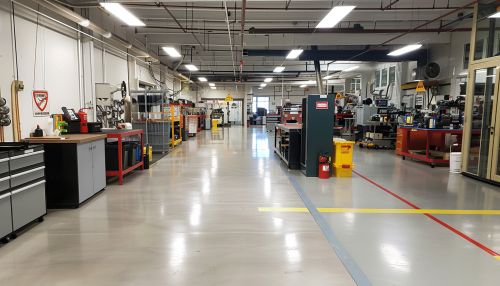Workplace Health and Safety
Overview
Workplace health and safety, also known as occupational safety and health, refers to the area of law and practice that deals with the protection of workers' health, safety, and welfare. It is a multidisciplinary field concerned with the safety, health, and welfare of people at work. This field aims to create a safe and healthy work environment, which is crucial in preventing the occurrence of work-related injuries, illnesses, and deaths.
History
The concept of workplace health and safety has been present in some form since the dawn of industry, with some ancient civilizations implementing rudimentary measures to protect workers. However, it was not until the Industrial Revolution that workplace health and safety became a significant issue due to the dangerous conditions in factories and mines. This led to the first pieces of legislation being introduced in the 19th century, such as the UK's Factory Act of 1833 and the US's Safety Appliance Act of 1893.
Legislation and Regulation
Workplace health and safety regulations vary by country. In the United States, the Occupational Safety and Health Administration (OSHA) sets and enforces standards to ensure safe and healthy working conditions. In the United Kingdom, the Health and Safety Executive (HSE) is responsible for workplace health and safety regulations. These organizations enforce regulations through inspections and can issue fines for non-compliance.
Risk Assessment
A key aspect of workplace health and safety is risk assessment, which involves identifying potential hazards in the workplace, assessing the risks associated with these hazards, and implementing measures to control these risks. This process is typically carried out by a Health and Safety Officer, who is responsible for ensuring that the workplace complies with health and safety legislation.
Training and Education
Training and education are crucial components of workplace health and safety. Workers must be educated about potential hazards in their workplace and how to protect themselves. This can be achieved through safety training programs, which may include instruction on topics such as proper equipment use, emergency procedures, and the use of personal protective equipment (PPE).
Personal Protective Equipment (PPE)
Personal protective equipment, or PPE, is equipment worn by workers to protect against health and safety hazards. PPE can include items such as safety glasses, gloves, hard hats, and safety shoes. The use of PPE is governed by regulations and standards, which specify the types of PPE required for different tasks and environments.
Ergonomics
Ergonomics is the study of people's efficiency in their working environment. It involves designing or arranging workplaces, products, and systems so that they fit the people who use them. Ergonomics can play a significant role in workplace health and safety, as poor ergonomics can lead to musculoskeletal disorders such as carpal tunnel syndrome and back pain.
Mental Health
Workplace health and safety also encompasses mental health. Employers have a duty to ensure that work does not cause mental ill-health or exacerbate existing conditions. This can involve measures such as stress management, providing support for mental health conditions, and fostering a positive working environment.
Workplace Health and Safety Management Systems
Workplace health and safety management systems (WHSMS) are comprehensive, systematic approaches to managing health and safety risks. They involve identifying, assessing, and controlling risks, as well as ensuring that these processes are continually improved. A WHSMS can help organizations to create a culture of safety and reduce the incidence of workplace injuries and illnesses.


